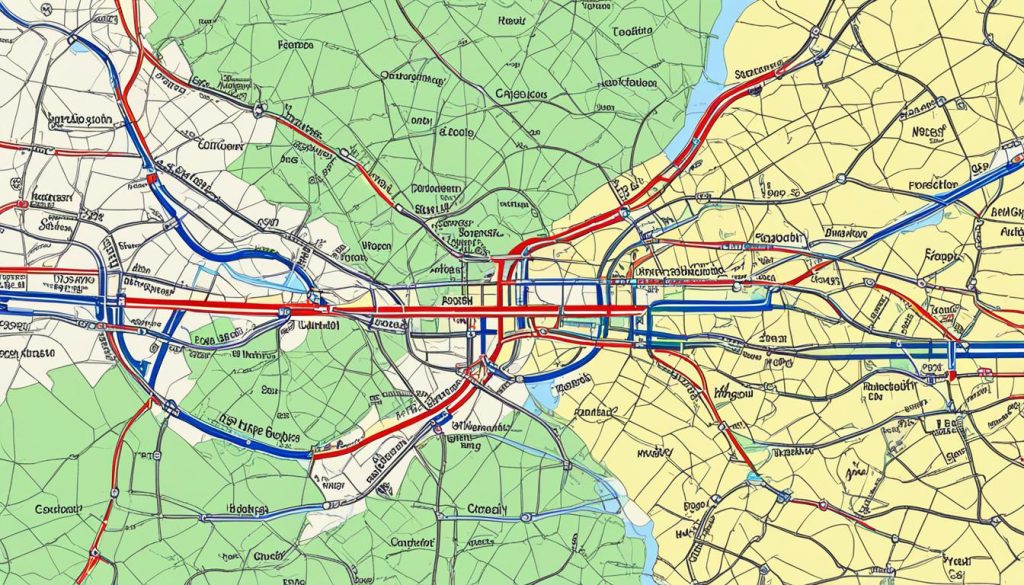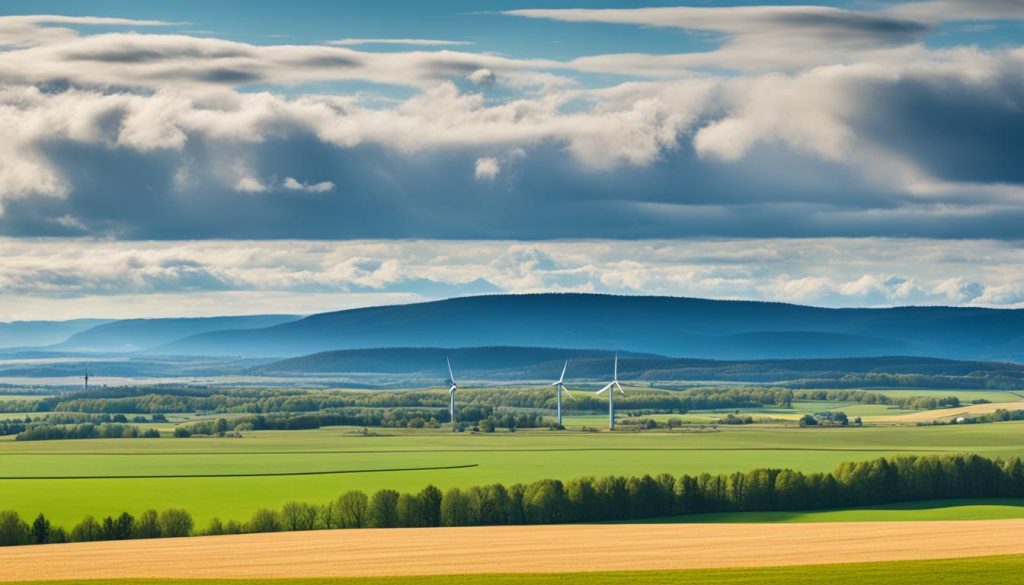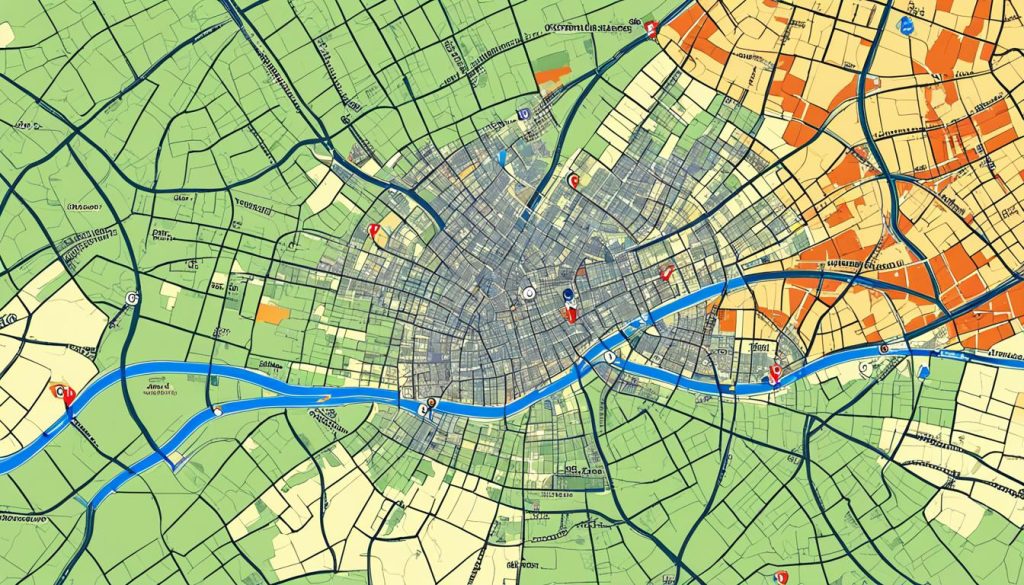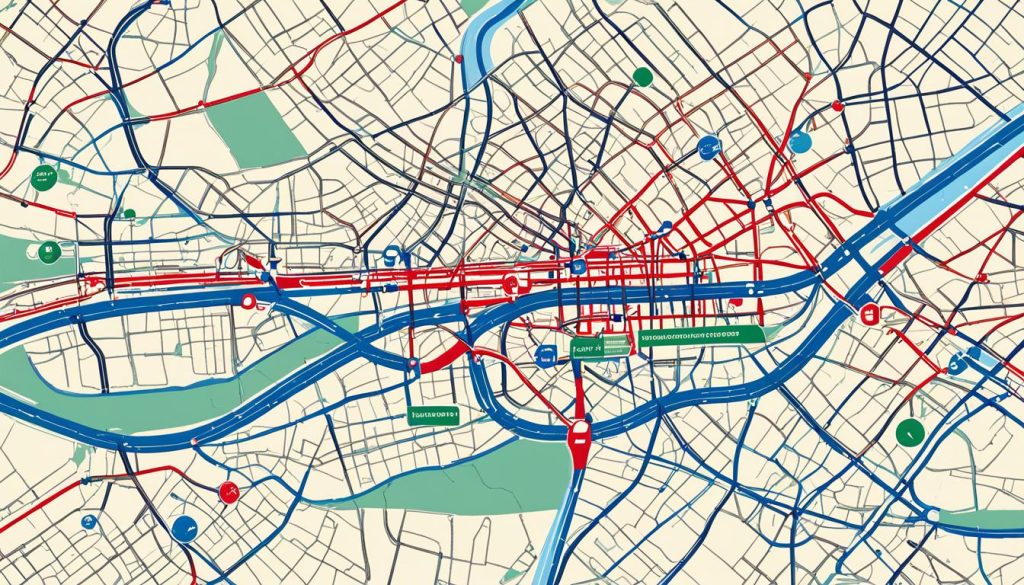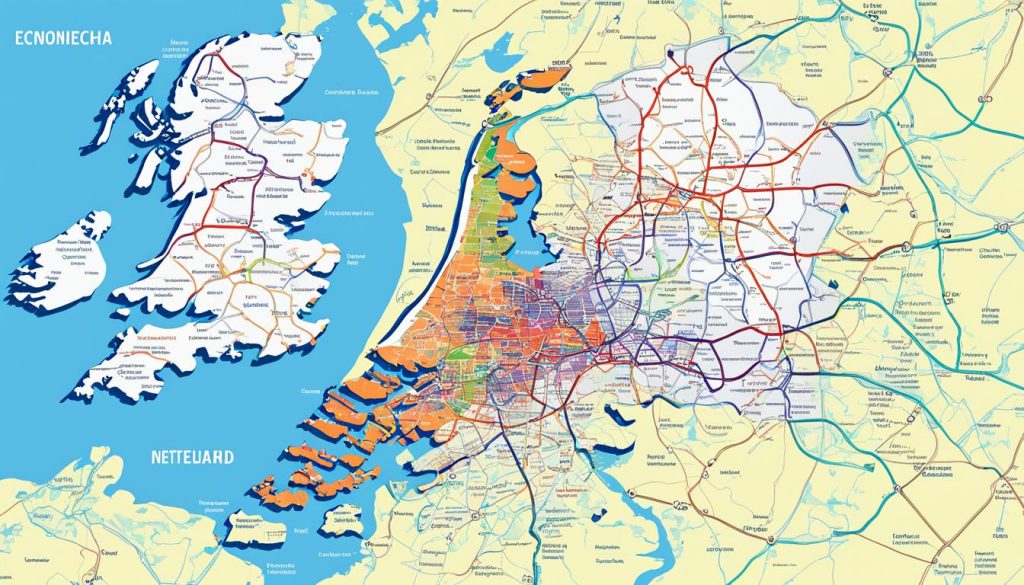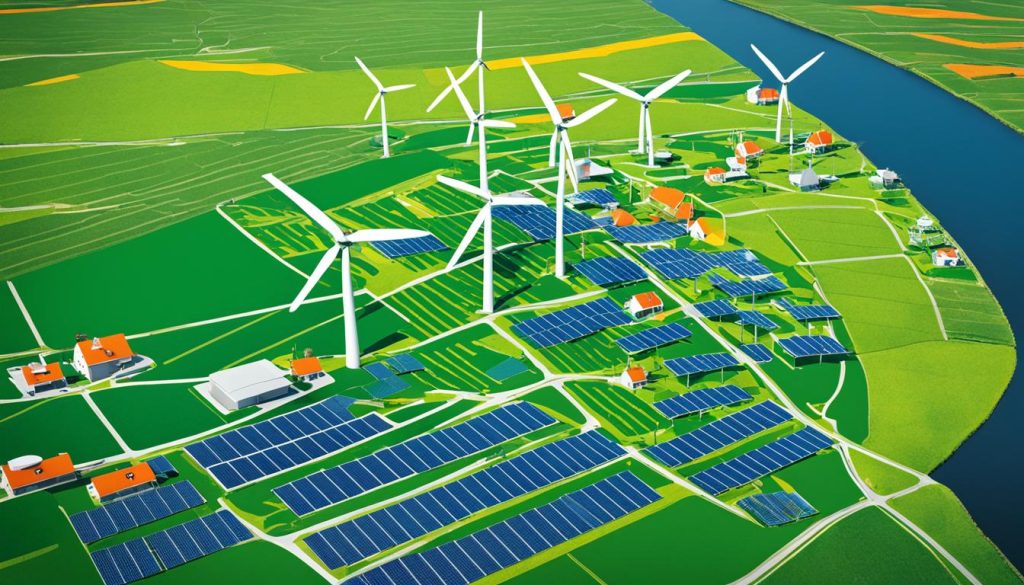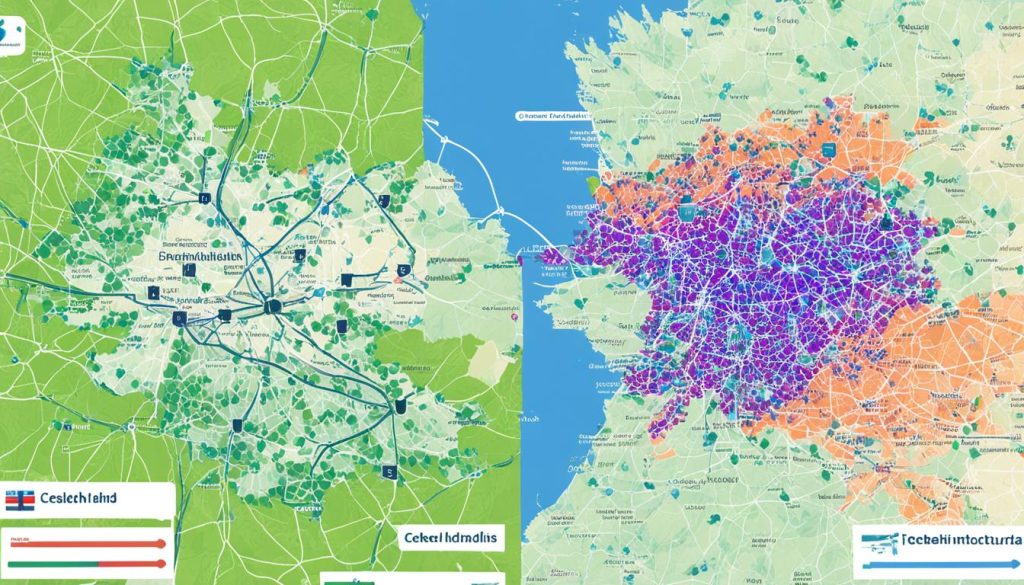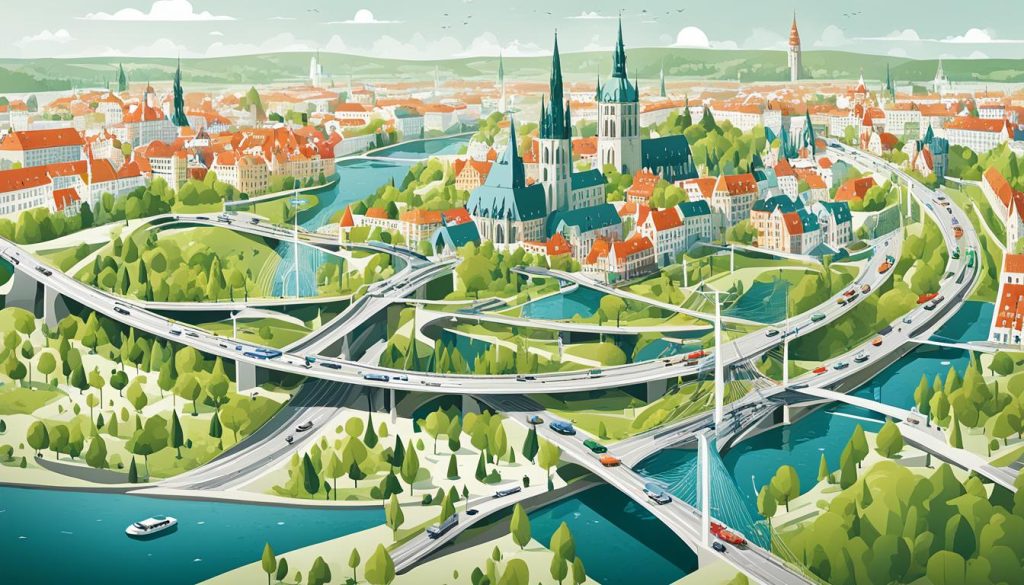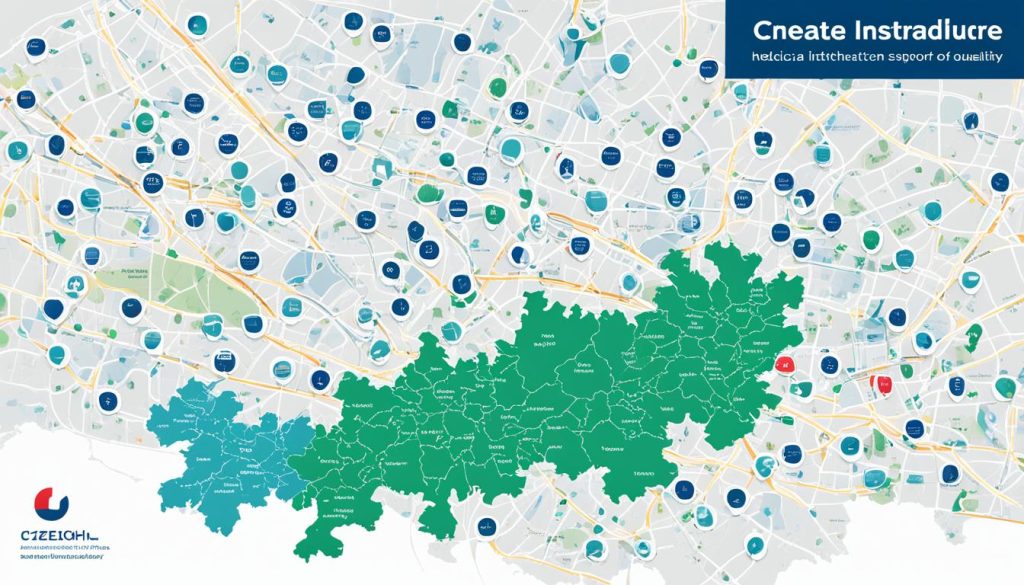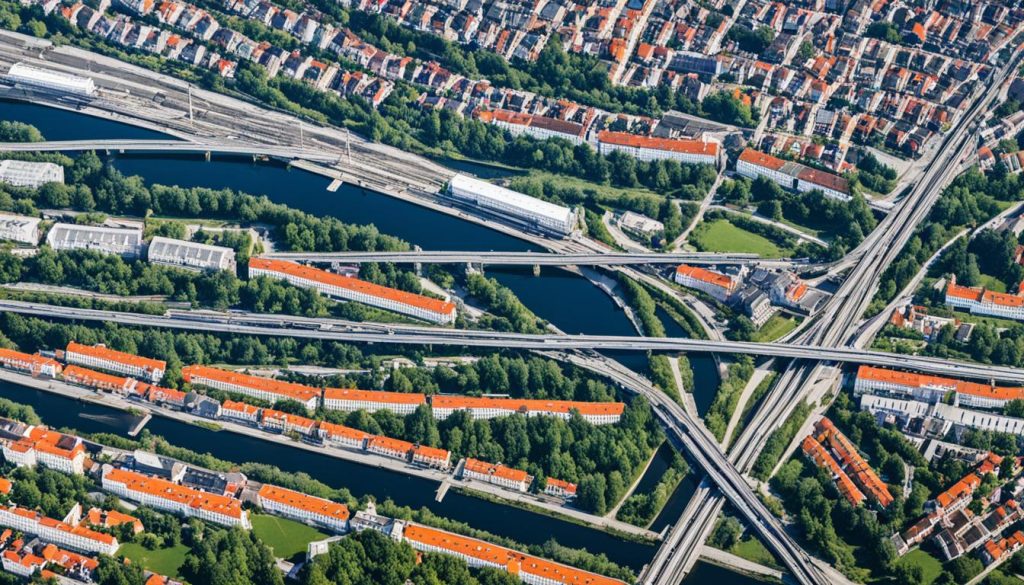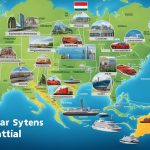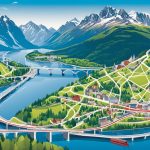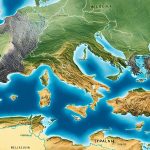A look at geography and infrastructure uncovers what makes nations unique. Comparing the Czech Republic and the Netherlands is fascinating. They lie in Central and Western Europe. This gives us a chance to explore diverse European landscapes. Their landscapes and infrastructure tell stories of growth. They show how each country has adapted to its place in Europe.
In comparing the Czech Republic and the Netherlands, we dive into their infrastructure. We will see what challenges they faced and how they overcame them. This journey through Europe’s geography lets us see how these countries manage their space. It’s key to understanding the puzzle of development across Europe.
Geographical Overview and Natural Landscapes
Europe showcases a variety of landscapes, with the Czech Republic and the Netherlands standing out. These countries have their own geographic identities, made unique by their terrain. The climate, environment, and rivers are key in both areas, influencing how people live.
Contrasting Terrains: Plains vs. Highlands
The Netherlands features vast, flat lands known as Dutch plains. These areas are often below sea level, protected by an extensive dyke system. On the other hand, the Czech Republic is home to highlands and mountains, offering diverse scenery. This variety influences agriculture and where people settle.
Rivers and Water Systems
- The Rhine, Maas, and Schelde rivers are crucial for the Netherlands, supporting transport and agriculture.
- The Vltava river in the Czech Republic powers hydroelectric plants and provides beautiful waterways for enjoyment.
Climate Differences and Environmental Concerns
- The Netherlands and Czech Republic have different climates that affect farming, energy, and lifestyle.
- Both face environmental challenges like pollution and sea level rise, needing smart policies to protect their futures.
Population Distribution and Urbanisation
The way people spread out and cities grow is key to understanding any area’s social life. As Europe sees big changes in where people live, cities like Prague and Amsterdam, and also small towns, are really affected. These changes show how people’s ways of living, the economy, and cultures are evolving.
Urban Centres: Prague vs. Amsterdam
Prague and Amsterdam are growing because more people want to live in cities. Prague draws folks with its beautiful buildings and rich history. It’s at the heart of the Czech Republic. Amsterdam, known for its canals and lively culture, is the core of the Netherlands. Both cities offer a look at city life but in their own special ways.
- Prague: It’s modern yet holds onto its heritage. Prague grows by keeping a balance between welcoming tourists and being a great place for businesses and new ideas.
- Amsterdam: Famous for being open-minded and for planning for a sustainable tomorrow, Amsterdam shows what modern cities aim to be like.
These cities show the variety in how European cities develop and what affects where people choose to live.
Rural Populations and Urban Sprawl
Countrysides near big cities face changes as those cities get bigger. These rural places meet both problems and chances for growth. People often move to cities looking for jobs and better living, which can make rural places smaller. Yet, these areas are important for a country’s culture and farming.
- Prague’s growth impacts nearby areas, but efforts are being made to revitalize those places and keep their culture alive.
- Amsterdam, near the Randstad area, offers an example of how city life and the calm of the countryside can blend together nicely.
To really get the full picture of how people decide where to live, we need to think about both cities and the countryside. They both play important roles in how Europe’s population looks.
In wrapping up, looking at Prague and Amsterdam helps us understand wider trends in where people live. These examples show that changes in urban and rural areas are part of a bigger shift in society.
Transport Networks and Accessibility
Spending on transport is key to a country’s growth, linking places and moving people and products around. The Netherlands leads in building good roads and train lines, making travel easier for everyone. Projects like the Multi-annual Programme for Infrastructure, Spatial Development, and Transport (MIRT) aim to boost the area’s economy by making transport better.
Road and Railway Infrastructures
The roads in the Netherlands are vital for travel. They use high-tech solutions to keep traffic flowing smoothly. The trains are also getting upgrades to be faster and more dependable. This work on roads and railways helps connect important regions, supporting lots of activities.
Public Transportation Systems
The Dutch public transport is a model of sustainability, with buses, trams, and ferries linking well with trains. This network makes it easy for people to get around and helps cut down on pollution. It shows the country’s commitment to keeping the environment green.
Air and Water Transport Comparison
Air and water travel expand the Netherlands’ transport options. The airports can manage many flights, making air travel crucial. Waterways and ports also play a major role, keeping the Netherlands competitive in global trade.
Economic Zones and Regional Disparities
The economic landscape of the Netherlands has been shaped by dominant economic zones, leading to regional disparities. The OECD notes the country’s efforts to improve economic performance and equity. They have adopted a tailored approach for this task.
The Randstad, a cluster of major Dutch cities, stands as an economic giant. The Netherlands aims to extend these benefits across the country. By focusing on economic zones, they hope to uplift regions that have fallen behind. The goal is to ensure balanced development nationwide.
- Investment in secondary cities and regional hubs outside the Randstad to stimulate local economies.
- Promotion of innovation and entrepreneurship in less developed areas to create new economic zones.
- Incorporation of rural regions into the economic growth narrative with specific sectoral policies.
Yet, regional disparities remain, with economic performance linked to proximity to major urban centres. Acknowledging this, the Netherlands is pushing policy reforms. These aim to boost regional connectivity and foster a resilient, inclusive economy.
- Enhanced physical and digital infrastructure to connect economic zones more effectively.
- Programmes that incentivize businesses to set up operations in underserved regions.
- Research and development grants aimed at sparking innovation outside traditional economic zones.
In doing so, the Netherlands seeks a fair economic landscape. It aims to reduce regional disparities and empower every area. This way, every region can contribute to the Netherlands’ global economic standing.
Energising Economies: Energy Sectors in Focus
Energy sectors in Europe are facing big changes. Countries like the Czech Republic and the Netherlands are finding new ways to deal with energy. They’re moving away from coal. Instead, they’re embracing cleaner energy sources. Dutch innovations are leading the way to a brighter, greener future.
Coal Dependency and Energy Transition in the Czech Republic
The Czech Republic has a tough challenge. It relies heavily on coal for energy. Coal affects everything from electricity to heating homes. But things are starting to change. From 2009 to 2019, coal use dropped by 19%. This is mainly because coal-fired power stations are being used less. The country is now focusing on how to use coal less. This change is critical for attracting investors and planning for the future.
Renewable Energy Adoption and Innovation in the Netherlands
The Netherlands is aiming for a greener future. It’s changing its national policies to support this goal. The focus is on regions known for their strong economy and innovation. This has led to a big increase in the use of renewable energy. Dutch innovations are playing a key role. They are creating new projects and investing in renewable energy. The Netherlands is not just adopting new energy sources. It’s transforming its entire energy landscape for the better.
- Creating strategic plans for energy transition is key in the Czech Republic. It helps reduce coal use and builds confidence among investors.
- In the Netherlands, embracing renewable energy fast and investing in innovation are vital. They’re essential for a resilient and sustainable energy future.
Tapping into Technology: Digital and Telecommunication Infrastructures
Digital advancements and telecom are key to a nation’s economic strength and connection. The world is becoming more connected every day. So, building strong internet and telecom networks is crucial, especially in the UK. These efforts help us stay ahead and lay the groundwork for new tech and innovation.
Connectivity and Internet Penetration
Internet connectivity is essential in today’s world, touching everything from buying things to learning. Now, having fast and stable internet is a must-have, not just a nice-to-have. That’s why there’s a big push to get more people online across the UK. The goal is to close the gap in digital access and give everyone fair chances to information and chances.
- Exploring the current landscape of internet connectivity across different regions.
- Assessing government strategies for boosting broadband and mobile internet access.
- Analyzing the correlation between internet penetration and economic development.
Investments in Telecommunication
Telecommunication networks are what keep our digital world connected. Putting money into telecom shows we’re getting ready for a digital future. It’s about looking at how investing in telecom can prepare us for upcoming tech and support a digital-led economy.
- Reviewing recent technological investments in telecommunication infrastructures.
- Identifying the catalysts for investment within the sector and their expected impacts.
- Understanding the role of public-private partnerships in expanding telecommunication networks.
We look into tech and telecom to see how ready the UK is for future innovations. Understanding these aspects can reveal how well the UK is gearing up for what’s next in the digital world.
Environmental Sustainability and Green Initiatives
The Netherlands leads in making environmental sustainability a big part of its plans. It turns problems like water management and climate change into smart policies. The country has committed to climate goals and sustainable infrastructure. This makes them leaders in green initiatives. Their work shows in policies and real projects that aim for a greener future.
The Dutch mix technology, community work, and new ideas for a sustainable life. Here are some ways they show their commitment:
- They have water systems that keep nature in balance, protect against floods, and make water cleaner.
- They support bikes and electric cars to cut down on fossil fuels.
- They use wind and solar energy to lower carbon emissions and rely less on old energy sources.
- They design cities with green spaces, eco-friendly materials, and buildings that save energy.
- They offer rewards for businesses and people who choose eco-friendly options and tech.
These actions highlight how serious the Netherlands is about green initiatives. They are making a big impact on fighting climate change. With more work on sustainable infrastructure, the country will not just reach but surpass its climate goals. This sets an example for environmental sustainability worldwide.
Healthcare and Social Infrastructures
The strength of a nation’s health and social services shows its dedication to people’s welfare. Both the Czech Republic and the Netherlands have built quality healthcare and strong social supports. Yet, we don’t have details on how these services differ in accessibility or structure.
Healthcare Accessibility and Quality
Quality healthcare depends a lot on accessibility. How resources are used impacts patient care speed and efficiency. In Europe, reaching people in rural or underserved areas is key to inclusive health policies.
Social Support Systems and Welfare
Health and welfare matter to a caring society. Social support helps the elderly, disabled, unemployed, and other vulnerable groups. Even without specific facts, it’s clear that both countries see social welfare as crucial.
Healthcare and social welfare are closely linked. Good healthcare aids societal development and affects the economy. That’s why healthcare and social programmes must work together for everyone’s well-being.
Our sources don’t give detailed info on healthcare or social support in the Czech Republic and the Netherlands. But it’s implied efforts are ongoing to better these crucial services. A closer look in the future might reveal how effective and accessible these systems are, and how well social welfare is working in both nations.
Challenges in Infrastructure Development
Addressing infrastructure challenges is crucial for sustainable growth and economic progress. Policy reforms aim to break down development barriers, but turning these efforts into success is complex. Both the Czech Republic and the Netherlands are dedicated to improving and investing in infrastructure to meet these challenges.
In the Netherlands, they’re focusing on policy reform with programmes like the Randstad urgency initiative. This aims to improve accessibility and boost regional development. It shows a commitment to developing transport and urban infrastructure for today’s and tomorrow’s needs. However, not all challenges are easily overcome; infrastructure planning involves long-term strategies and significant resources.
- Strategic policy initiatives to tackle infrastructure challenges.
- Extensive planning for overcoming geographical and logistical development barriers.
- Comprehensive policy reform, aiming at efficiency and sustainability.
- Investments in projects promoting balanced regional development.
Despite their efforts, both countries face obstacles in infrastructure development. These include environmental concerns, complex stakeholder negotiations, and the need for large financial investments.
- Significant environmental assessments to reduce ecological damage.
- Effective stakeholder cooperation for smooth project execution.
- Finding funds without affecting other socio-economic areas.
For true progress in infrastructure, policy reforms must be flexible and inclusive. They should meet the varying needs across regions. The link between local goals and national policies helps create dynamic infrastructure systems. These systems enhance regional growth and the wealth of the nation.
Comparative Education Systems and Academic Infrastructures
Exploring educational systems in different countries shows their academic ideals and priorities. The Czech Republic and the Netherlands offer top educational chances. Their approaches give students special learning experiences. It’s vital to understand their educational structures and research facilities to judge their quality and performance.
Educational Frameworks and Opportunities
In the Czech Republic and the Netherlands, education goes beyond regular classes. It includes access to higher learning, job training, and tech in teaching. These factors show how strong an education sector is.
- The Czech Republic’s dedication is to broad and detailed academic routes with a focus on science.
- The Dutch system is ahead in teaching methods, fostering creativity and analytical skills.
Research and Development Facilities
R&D is key in advanced education, laying the groundwork for new discoveries and industry growth. The R&D centers in these countries are essential for encouraging research and progress.
- Looking into how educational frameworks back R&D in universities and research places.
- Studying joint ventures among schools, companies, and governments, leading to active learning environments.
To conclude, comparing education systems highlights their different academic setups. These setups aim to provide broad learning chances. The variations stem from cultural norms and the goals countries have for their youth.
Trade and Transportation Corridors
Trade corridors help grow global commerce and connect economies. In Europe, they link cities and countries, making it easy to move goods, services, and people. Their role in boosting the economy, especial in countries like the Czech Republic and the Netherlands, is vital.
The Netherlands is a great example of investing in transport to remain competitive. Improving trade routes has made it a key commerce centre in the EU.
Creating and keeping up these pathways drives business but comes with challenges. They need the latest technology and careful planning. This ensures they can handle the traffic that is crucial for economic growth.
- Place logistics centres smartly along corridors for better distribution.
- Use multimodal transport facilities to make supply chains more efficient.
- Always work on infrastructure to remove delays and speed up deliveries.
Transportation networks include roads, trains, ships, and planes. How well these work together affects logistics. This, in turn, impacts trade, job opportunities, and wealth creation.
In summary, even without specific details for the Czech Republic and the Netherlands, the importance of trade and transport networks is undeniable. They are key to a strong economy and logistics.
Impact of Geographical Location on Economic Activities
A country’s strategic location deeply affects its economic activities and growth. It offers many regional advantages, shaping the nation’s economic scene. The Netherlands shines as a key example due to its coastal spot at Europe’s heart. This position boosts trade and strengthens its economic role globally.
In the Netherlands, its strategic location fuels economic success, especially in vibrant city-regions. These areas are hubs for both financial power and innovation. They show how a good location can give a country an upper hand in global competition. This highlights how closely tied geographical impact and economic activities are.
- Being close to major European markets aids trade and logistics.
- Easy access to the North Sea makes it a top shipping spot, pointing to the Netherlands as the ‘Gateway to Europe’.
- Key facilities like Amsterdam Airport Schiphol and the Port of Rotterdam play a big part in this strategy.
The tale of the Dutch shows how turning geographical impact into economic activities leads to growth. While we lack similar analyses on the Czech Republic, its central spot and industrial background hint at its potential. This includes taking advantage of its regional benefits.
- The Czech Republic’s central location helps its manufacturing and export sectors.
- Being in the heart of Europe could boost its role in European trade and transport.
These examples prove that a nation’s geographical setup plays a crucial, active role in defining economic activities. By using their regional advantages, both the Netherlands and potentially the Czech Republic, show a strong link between location and economic future.
Housing Markets and Property Development
The housing market critically impacts economic stability and citizen well-being. Urban planning tries to find a balance between people’s housing needs and sustainable development. Property development is complex and needs careful investment decisions. When we talk about the housing market and property development, two main issues come up: how affordable housing is and the latest investing trends.
Affordable Housing and Urban Planning
Finding affordable housing solutions is key to urban planning. This challenge involves social, economic, and environmental aspects. Success depends on teamwork among government, developers, and communities. Considerations include the availability of land, zoning laws, and developing infrastructure. The aim is to provide affordable homes that improve quality of life.
- Make the planning process quicker to help build new homes
- Use zoning laws to ensure a variety of home types for all income groups
- Find new ways to fund affordable housing, like partnerships between public and private sectors
- Revive underused areas with buildings for both living and business
Real Estate Trends and Investor Interests
The strategies for real estate investment have changed to meet current demands and predictions. Real estate trends show wider economic conditions and influence investors. For investors, understanding these trends is essential for making good choices.
Important real estate trends right now include:
- New technologies in building and managing properties, for example, eco-friendly buildings and smart homes
- The popularity of remote work changing the demand for homes and office spaces
- An increase in projects that save energy and protect the environment
- Projects that regenerate forgotten urban areas
In the UK, examining the housing and property development sector shows the need for supportive policies. These should promote fair housing and clever urban planning while attracting real estate investments.
Conclusion
In conclusion, the Czech Republic and the Netherlands have taken different paths in development due to their own goals and challenges. The Netherlands focused a lot on improving policies to boost its infrastructure. This focus is strengthening their cities and pushing them towards being more competitive economically. They are particularly keen on innovating and integrating solutions to improve environmental sustainability.
The Czech Republic, though not as highlighted in this study, is making big steps towards changing its energy use. The country is moving away from coal, aiming to use energy more efficiently. This change is leading them towards sustainable energy sources, cutting down their environmental impact.
Both countries are working hard, using their unique strategies in government policy and regional development. Although getting detailed comparisons was difficult, it’s clear they are both aiming for growth that is responsible and beneficial for their societies. They want to build communities that are strong and can withstand challenges.

